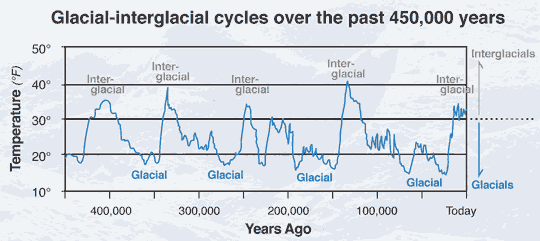Are these the same ice cores that show an 800 to 1,000 year lag between temperature and CO2?
{...
This is an issue that is often misunderstood in the public sphere and media, so it is worth spending some time to explain it and clarify it. At least three careful ice core studies have shown that CO2 starts to rise about 800 years (600-1000 years) after Antarctic temperature during glacial terminations. These terminations are pronounced warming periods that mark the ends of the ice ages that happen every 100,000 years or so.
Does this prove that CO2 doesn’t cause global warming? The answer is no.
The reason has to do with the fact that the warmings take about 5000 years to be complete. The lag is only 800 years. All that the lag shows is that CO2 did not cause the first 800 years of warming, out of the 5000 year trend. The other 4200 years of warming could in fact have been caused by CO2, as far as we can tell from this ice core data.
The 4200 years of warming make up about 5/6 of the total warming. So CO2 could have caused the last 5/6 of the warming, but could not have caused the first 1/6 of the warming.
It comes as no surprise that other factors besides CO2 affect climate. Changes in the amount of summer sunshine, due to changes in the Earth’s orbit around the sun that happen every 21,000 years, have long been known to affect the comings and goings of ice ages. Atlantic ocean circulation slowdowns are thought to warm Antarctica, also.
From studying all the available data (not just ice cores), the probable sequence of events at a termination goes something like this. Some (currently unknown) process causes Antarctica and the surrounding ocean to warm. This process also causes CO2 to start rising, about 800 years later. Then CO2 further warms the whole planet, because of its heat-trapping properties. This leads to even further CO2 release. So CO2 during ice ages should be thought of as a “feedback”, much like the feedback that results from putting a microphone too near to a loudspeaker.
In other words, CO2 does not initiate the warmings, but acts as an amplifier once they are underway. From model estimates, CO2 (along with other greenhouse gases CH4 and N2O) causes about half of the full glacial-to-interglacial warming.
So, in summary, the lag of CO2 behind temperature doesn’t tell us much about global warming. [But it may give us a very interesting clue about why CO2 rises at the ends of ice ages. The 800-year lag is about the amount of time required to flush out the deep ocean through natural ocean currents. So CO2 might be stored in the deep ocean during ice ages, and then get released when the climate warms.]
...}
RealClimate: This is an issue that is often misunderstood in the public sphere and media, so it is worth spending some time to explain it and clarify it. At least three careful ice core studies have shown that CO2 starts to rise about 800 years (600-1000 years) after Antarctic temperature during...

www.realclimate.org



